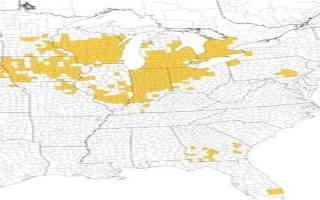By Andrew Kness
Before anyone panics, this disease has not been confirmed in Maryland or Delaware; however, it is close by and could potentially spread to our state. As you’re scouting fields this summer, keep this one in the back of your mind.
Tar spot is a fungal disease of corn caused by Phyllachora maydis. It was first discovered in the United States in 2015. In Latin America where tar spot is more common, another fungal species, Monographella maydis, is known to occur in complex with P. maydis; however, only P. maydis has been found in the United States.

Figure 1. Map of tar spot in the United States after the 2021 growing season. Map generated from: https://corn.ipmpipe.org/tarspot/.
The initial occurrence of tar spot in 2015 was limited to a couple of counties in Indiana, but by 2018 it had spread across much of the US corn belt and caused serious economic damage. In 2020, tar spot was confirmed in corn fields in Lancaster County Pennsylvania, then the surrounding York, Cumberland, Dauphin, and Lebanon counties in 2021 (Fig 1). We believe this large geographic jump from the corn belt to PA was from variety trial seed that was inadvertently contaminated with infected corn residue.
Symptoms of tar spot are the presence of glossy black, raised lesions on the leaves (Fig 2). These lesions look like someone splattered paint or tar on the leaves, hence the name. These symptoms have been observed to occur from VT to maturity. Lesions are also visible on dried plant parts.
The fungus that causes tar spot overwinters in infected corn residue; however, it is unknown how well, or if, this pathogen will overwinter here in Maryland or if this disease will be of any economic importance in this region.
Currently, there are no management recommendations for this disease for our area, because as stated, it is yet to be confirmed in Maryland and unknown if it will be a problem. For the 2022 corn crop, be on the lookout for this disease in your corn fields, especially if your have any corn hybrid trials or demos planted in your field. If you suspect you found this disease, please contact your local Extension agent and/or submit a sample to the Plant Diagnostic Lab.
Source : umd.edu